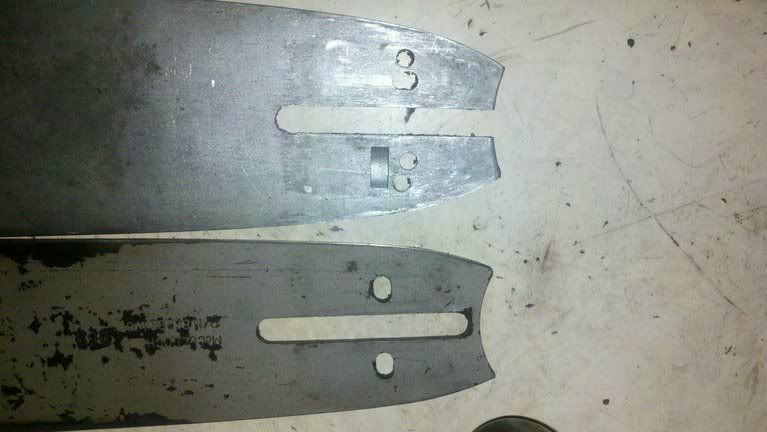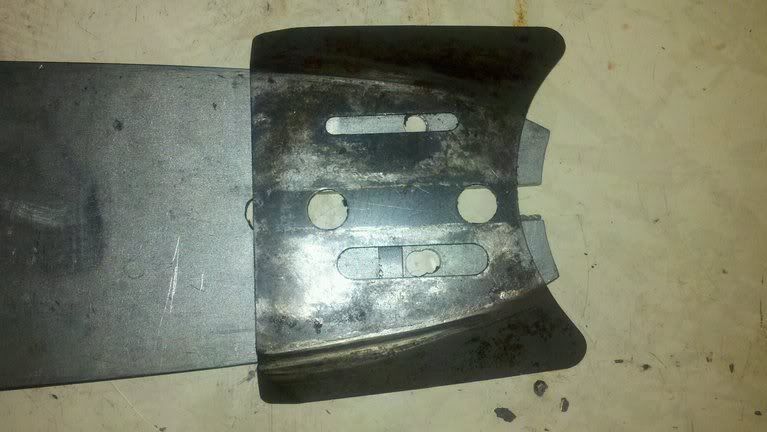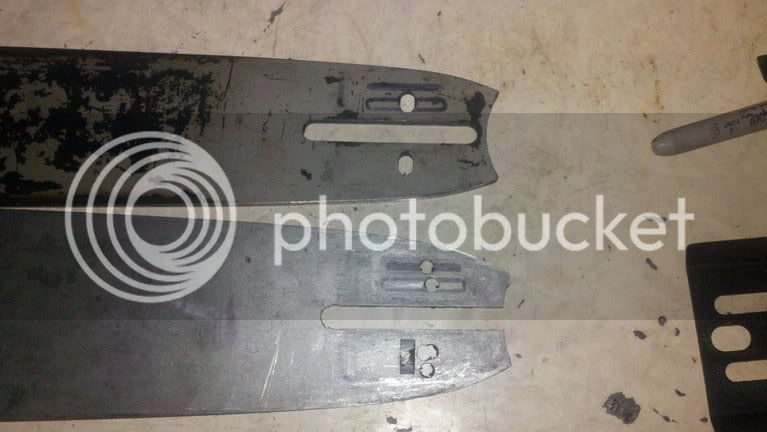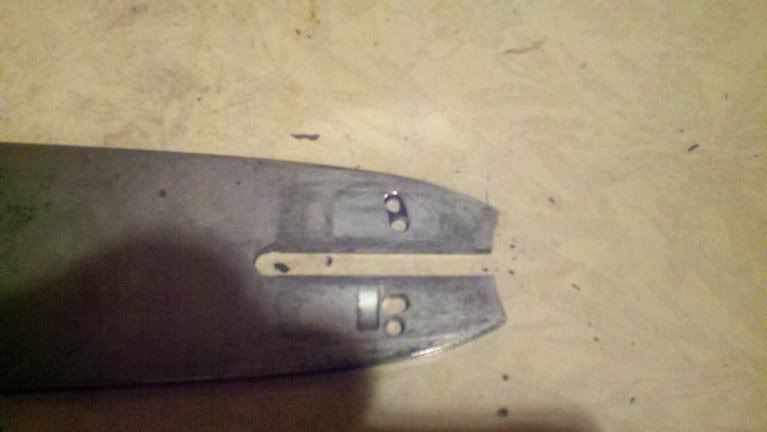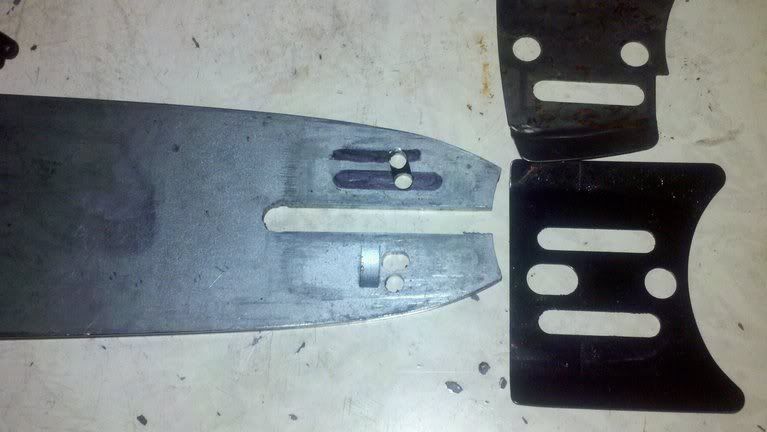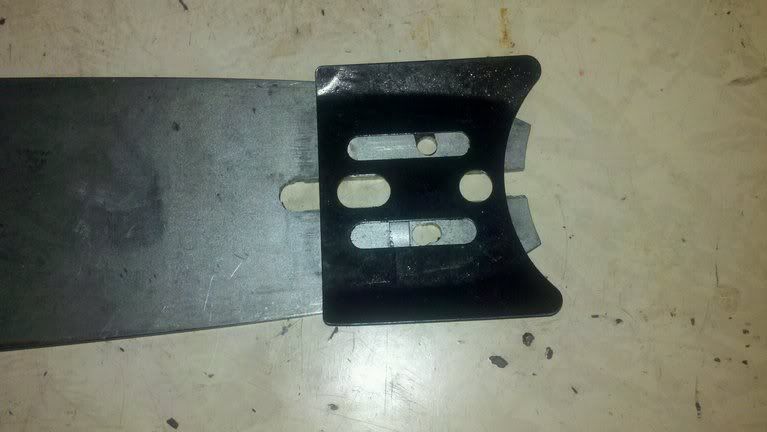Large Frame McCulloch Bar Plate and Bar Mount Pattern Issues Part-2
Now on to bar tail oiler hole/slot differences, and the problems they can cause when used wit the wrong inner bar plate.
The early bar tail setup has two holes on each side. The more centered hole only functions as a place for the tensioner peg to fit into. The other, more outward hole feeds oil to the bar rail. A late style bar plate BLOCKS this hole rather than feeds it. The oiler slot on a late bar plate only feeds oil to the top adjuster hole when used on an early style bar. This hole isn't in use for anything (the adjuster peg is below the bar studs on these saws), and also doesn't have an oil passage which leads to the rail. This means the oil goes
nowhere. The higher oil slot on the early style bar plate allows oil to go from the well in the bar pad to the upper hole in this style bar tail, feeding the rails. I have Oregon and McCulloch bars with this two hole, early bar plate ONLY pattern.
The later style bars have a pair of elongated combination oiler and tensioner holes. When mounted on the saw, the bottom hole accepts the tensioner peg, and the upper hole receives oil and feeds it through a slot to the bar rail. If an early style inner bar plate is used with this bar tail style, the oiler slot on the bar plate feeds oil to NOTHING except the side of the bar (as the slot is too high to feed the oblong adjuster/ oiler hole). The chain will run dry.
A McCulloch branded early 'four hole' style bar on top. Late "enlarged 10-series) 'two hole' style bar on the bottom.
An early McCulloch inner bar plate on the same early McCulloch branded bar. You can see that the oiler slot lines up with the oiler hole. You can also see the early 'thumbnail' cut in the bar for the early bar tensioner screws. It's unneeded on most of the large frame Macs (which instead have the adjuster in their clutch covers).
Late style 'two hole' bar on top. Early style 'four hole' bar on bottom. On both bars, the solid black lines show where the early style bar plate oiler slot lines up. Also on both bars, the 'hollow' black outlines show where the late style bar plate oiler slot lines up. You can see that the early bar plate oil slot feeds the early style bar oil hole fine, but is too high for the late style bar oil hole. You can also see that the late style bar plate oil slot feeds the late style bar adjuster/oiler hole fine, but is too low for the early style bar oiler hole (and only feeds oil to the 'blind' adjuster hole above the bar stud slot).
One other large frame McCulloch bar tail oiler style has a diagonal slot cut into it. This slot connects the inner hole of the bar (which serves as the tensioner pin hole when it's oriented below the bar studs) with the outer hole of the bar (which is the oiler hole that feeds a passage that leads to the bar rail). Unfortunately, I don't have a picture of this style oiler slot, and couldn't find a bar in my shop which has it. I've seen a few McCulloch labeled bars (and others) with this slot. I have also seen other bars that were obviously modified to a variation of this style by an end user sometime in the last 40 years. I didn't understand why............but now I do....
There's a few ways to use an early style 'four hole' bar on a saw that's currently equipped with the late style bar plates.
1)Swap on an early inner bar plate (McCulloch part # 61995). You can leave the late style outer plate on the saw. The McCulloch # for the outer plate is 61996. This plate will NOT work as an inner. It has the upper oiler slot as well, but that's not used when mounted on a direct drive Mac (or a gear drive with the bar mounted on the 'outer' possition such as my 650). That plate was used as an inner on the large frame gear drives (1-80 series, 890, etc) when the bar was mounted in the 'inner' possiton, since they feed oil from the right side of the bar (instead of the left).
2)Cut/butcher your late style inner bar plate so that it has a higher oiler slot that allows oil to get to the upper hole on the two hole bars. That's spring steel, and hard to cut accurately IMHO.
3)Slot the bar tail between the inner (adjuster) and outer (oil) holes. Do this on the upper side, as it faces the saw. Do it for both sides so the oiler will work when you flip the bar for even wear. Looking at the tail of the bar with the bar upright and pointing away from your face (like it's your nose), the correct spots to cut are the upper left and lower right. The bar steel is easy to cut accurately if you take your time.
Here's the same 'four hole' style bar from the earlier pics. I've slotted beween the adjuster and oiler holes on the two faces where the oiler slot of the bar plate will sit. Used a dremel tool with a reinforced cutting wheel. Took my time, and carefully slotted it about 1/2 the thickness of the bar. This gave a 'passage' (when the flat face of the bar plate is on it) about the same size as the passage that runs from the oiler hole to the rail. The bar can now be used with both early and late style plates, as the last two pics show.
As for running a late style bar on a saw with early style plates..............you can either swap the extrememly easy to find later style plate on the saw, cut your somewhat rare early style plate (not my choice), or maybe radius the outer edge of the combo adjuster/oiler holes (on the top of the bar, as it faces the bar pad.......for each hole) so that the early plate slot will feed it. I think I'd just get an easy to find/cheap late style bar plate to use with a later style bar however......
Why McCulloch switched these things around I haven't a clue. The bar pad casting on the saws doesn't appear to have been changed (other than the tensioner style change, and that doesn't affect the oiler situation). My guess is to have their large frame bars and bar plates be more like the 10-series setup. It does work well, although I'm confused as to why they didn't make those combination adjuster/oiler holes just a little bit larger so they'd work with the early style bar plates. They must've figured that the dealers would be able to sell the customer a new inner bar plate to work with the new bar they were buying for their 5-15 year old (at the time) saw.
Sorry for the long, wordy posts. Been chewing on this one for months. Took some pics a few weeks ago when I had stuff on the bench to shoot. I was also modifying that early 'four hole' bar before sending it to Keith to use on his Super 250 (with late style bar plates). I'll be modifying my remaining early style bars in the same way when needed for use on my saws with late style plates (and that's most of my LF Macs). My 650 came to me with a 'four hole' Oregon bar..............and no inner bar plate. The outer was a late style bar plate, and the guy I got the saw from told me his father (the original owner) "traded in" the 36" bar/chain for the 24" Oregon B/C that was on the saw when I got it because "it was more handy" (ugh). His father must've realized that the late style inner bar plate that his saw came with was not letting his saw oil the chain.....................and just ditched the inner plate rather than buy an early style inner plate (or modify the bar). The bar I swapped on (prompting this whole mess here) was a late style NOS 31" hardnose. I had a spare late style inner plate from a parts saw, and on it went.











